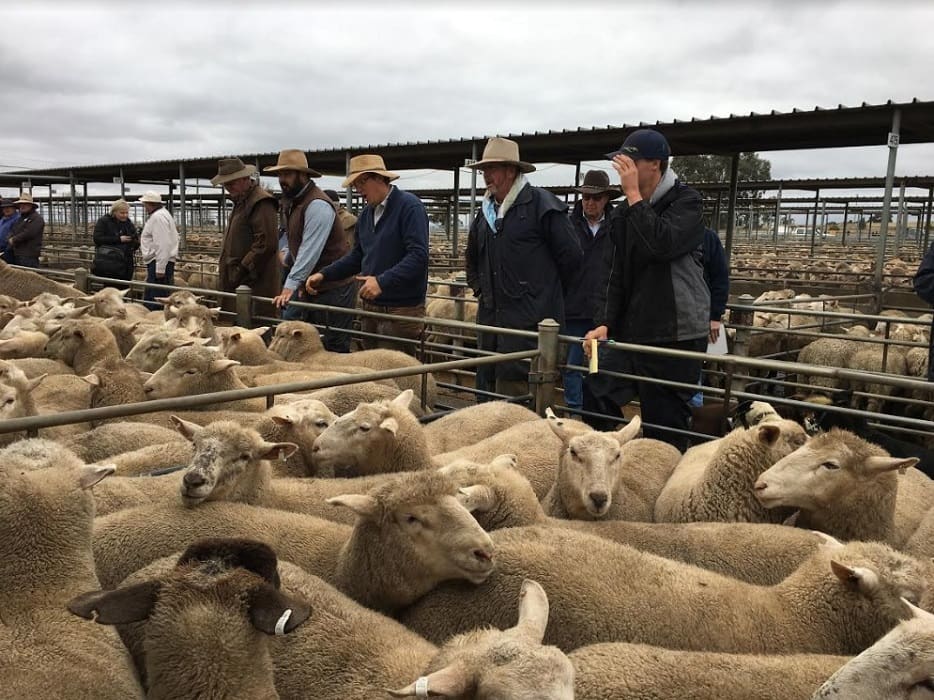
The GJ Hulm and Co team led by auctioneer Isaac Hill sell the $276.20 lambs at Wagga.
WAGGA Wagga stock agent Isaac Hill set a new national lamb sale record of $276.20 yesterday, but he estimated they could have been some of the cheapest lambs in the saleyard on a dressed cents per kilogram basis.
The GJ Hulm and Co auctioneer set the record with 168 rising 12 month-old Poll Dorset and White Suffolk cross lambs out of first cross ewes from Riverina lamb producer Doug Constance.
The lambs were sold to Southern Meats at Goulburn and were estimated by Mr Hill to have a carcase weight of 40-42kg and a skin valued at $10, giving them a cwt price of 630-650c/kg.
“They could nearly have been the cheapest cents per kilogram lambs I sold for the sale, would you believe?”
Most killable lambs at eastern states’ saleyards sold for 690-730c/kg this week and at Wagga, the National Livestock Reporting Service said plenty of shorn and longer wool lambs broke the 800c/kg cwt barrier as the sale progressed.
The NLRS said Wagga’s better presented trade lambs gained up to $17 to average 767c/kg cwt. The heavy and extra heavy lambs met keen biding from domestic buyers to average 716c/kg cwt. Lambs 26-30kg sold to $235.20 and those above 30kg cwt averaged 695c/kg. Merino lambs weighing 28kg sold to $218.20 and restockers paid $100-$136 for well-bred lines with weight and frame.
Record broken twice in one day at Wagga
Last week’s previous Australian saleyard lamb price record of $260 set at Forbes was broken twice in the same day at the Wagga saleyards yesterday, after a steady climb in prices over recent weeks as supplies dwindle. The Constance lamb sale followed the sale of about 40 35kg cwt lambs for $263.20 by Riverina Livestock Agents for Lockhart producer GD Lawson.
Mr Hill said processors estimated the Constance lambs would dress out at 37kg, but he believed the line, which had been fed on a lupin-barley feedlot ration, would yield better.
Mr Constance said he was surprised and humbled at the price he received.
“It’s a bit surreal.”
His seconds yesterday sold for $257 and he has averaged about $245 for 700 lambs this year. Mr Hill said despite buying grain and lupins for lower prices off the header earlier in the year, the record-priced lambs were “behind the eight ball” on margin for most of their time in the feedlot until saleyard prices rose recently.
Wagga might not hold record for long
Mr Hill believed Wagga might not hold the national lamb price record for very long, as exporters search urgently for supplies among the dwindling supplementary-fed lines being offered in the nation’s saleyards.
The Wagga saleyard held the record briefly at its previous sale a week earlier at $258.20 meaning prices for the best extra heavy export lambs had jumped nearly $20 in a week.
“So if it has jumped $20 in a week on the record, I don’t know where it is going to stop,” Mr Hill said.
“Equally Fletchers goes into maintenance for two weeks starting next week so therefore there is one player out of the market, so maybe it might hold for longer than we think – who knows what it going to happen.”
Mr Hill said the strength of the demand was illustrated by three export buyers – from Fletcher International Export, Thomas Foods International and Goulburn Meats – “knocking” the Constance lambs at his asking price of $268 and “away it went.”
Mr Hill said there are limited supplies of extra well-finished lambs available.
“Most people have elected to sell the grain and sell the lambs at lower weights, because of the value of the grain and the percentage of these big export lambs has reduced because of it.,” he said.
Mr Hill said buyers would also struggle to find new season lambs for some time in New South Wales.
Proposed new lamb definition might have helped supplies
The proposed new lamb definition that would allow more heavier old lambs to be sold – with an incisor broken but not in wear — might have benefited the supply situation, he said.
“But most people have a 12 month cycle, because they have still got to keep making room for the next generation.
“It (the proposed new lamb definition) will certainly make a different right on these fringe times; from here until the end of August we start getting a lot of hoggets through the system,” he said.
“Certainly it will help that side of it, if they can have an element of a (teeth) rupture or one lost tooth without being penalised drastically,” Mr Hill said.
Riverina Livestock Agents auctioneer James Tierney said on a cents per kilogram basis the trade lambs were the dearest at Wagga and the super heavy weight lambs were among the cheapest.
He expected lamb prices to remain strong for the next couple of months.
“Whether it can sustain yesterday’s rates who knows, but it will be strong.
“It depends on how long the abattoirs can stand it, I suppose,” he said.
“Our lambs are not going to go on for forever and numbers of will gradually decrease, especially the good ones.”
Mr Tierney said new season lambs would be dear and there won’t be many of quality.
“Any numbers of trade weight suckers are still two months away.”



HAVE YOUR SAY